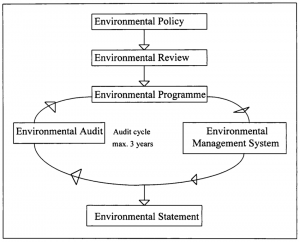Lesson 4 – The Eco-Management and Audit Scheme regulation
Welcome to the online course on EMAS, the Community’s eco-management and audit scheme! This course is designed to help organizations understand the EMAS regulation, its requirements, and how it can be used to improve their environmental performance.

EMAS is a voluntary scheme that requires organizations to participate in order to improve their environmental performance by establishing and implementing environmental management systems. This is achieved by objectively, systematically, and periodically evaluating an organization’s environmental performance and providing information on environmental performance along with an open dialogue with the public and other interested parties and training for employees.
To receive EMAS registration, organizations must meet certain requirements, including reviewing and identifying significant environmental aspects, applying the best environmental management practices, conducting an internal audit, and preparing an environmental statement.
EMAS-registered organizations may use the EMAS logo to demonstrate their dedication to improving their environmental performance. The Sectorial Reference Documents (SRDs) serve the purpose of promoting best environmental management practices (BEMPs). SRDs also contain sector-specific environmental performance indicators and benchmarks of excellence or rating systems that identify environmental performance levels.
EMAS Regulations require organizations to report on their environmental performance based on generic and sector-specific performance indicators. The environmental aspects that should be considered include emissions to air, releases to water, production, recycling, reuse, transportation and disposal of solid and other wastes, use and contamination of land, use of natural resources and raw materials, use of additives and auxiliaries as well as semi-manufactured goods, local issues, transport issues, risks of environmental accidents and impacts arising or likely to arise as consequences of incidents, accidents, and potential emergency situations, and effects on biodiversity.
The indicators that apply to all types of organizations include energy efficiency, material efficiency, water, waste, biodiversity, and emissions. The issue of emissions relates to greenhouse gas emissions, SO2, NOx, and particulate matter to the atmosphere. Organizations are exempt from reporting if they demonstrate an appropriate justification for claiming that the indicator does not apply to their specific situation.
EMAS was initially available to organizations in industrial sectors and has been available for participation since 1995. All organizations, regardless of size, type, or sector, have been able to participate in EMAS since 2001. Several SRDs have been developed or are in the process of being developed, including car manufacturing, electrical and electronic equipment manufacturing, food and beverage manufacturing, construction, agriculture, retail trade, tourism, telecommunication and ICT services, and waste management.
BEMPs are identified, evaluated, and documented for different sectors in close collaboration with stakeholders as part of the European Commission’s Joint Research Centre. The JRC follows the frontrunner approach, implementing innovative solutions at full scale that allow frontrunners to achieve the best environmental performance. Best environmental management practices (BEMPs) are not only technical or technological but also soft actions and management choices that result in the best possible environmental performance and have been proven to be technically feasible and economically viable.
In this course, you will learn how to implement EMAS, comply with its requirements, and improve your organization’s environmental performance. By the end of this course, you will understand the EMAS regulation, the requirements for EMAS registration, and how to apply best environmental management practices to improve your organization’s environmental performance.